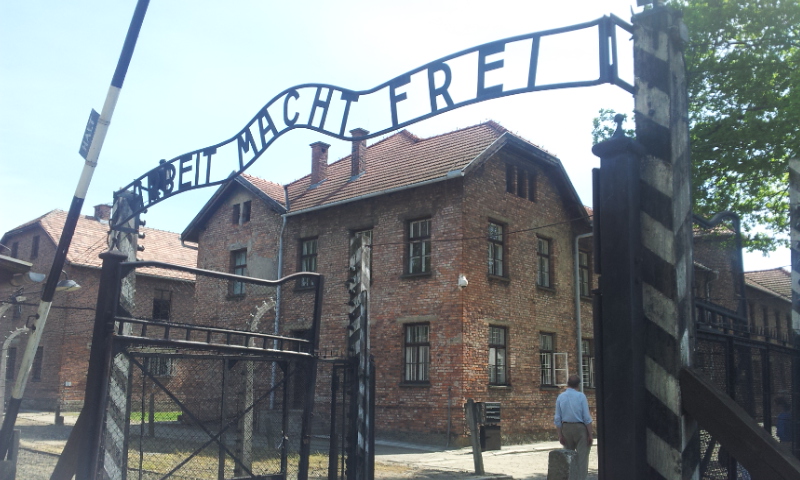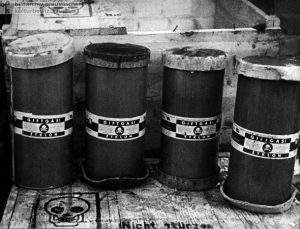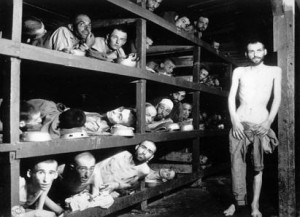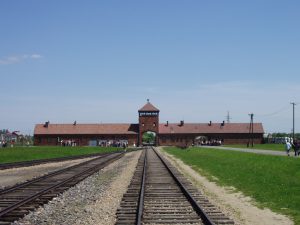Auschwitz Concentration Camp
By Tracy A. Burns
While Auschwitz originally consisted of Auschwitz I, Auschwitz II, Auschwitz III, and 45 satellite camps, the museum, located 50 kilometers west of Krakow, Poland, covers Auschwitz I, the former administrative area and the place where 70,000 people died, and Auschwitz II – Birkenau, designed by high-ranking SS officer Heinrich Himmler and responsible for the deaths of at least 960,000 Jews; 75,000 Poles and 19,000 Roma. Visitors can practically see and feel the atrocities of the Nazi terror as the cruelty of the era rips through one’s heart and stabs one’s soul.
Auschwitz I
 In 1940 the Nazis converted deserted barracks at a railway junction into one of the most horrific places in history – the Auschwitz I concentration camp, now with 16 one-story buildings. While the site was originally intended for Polish political prisoners, soon people from all walks of life were confined and executed here – Jews, Soviet prisoners-of-war, and Czechs, to name a few. In 1942 as many as 20,000 prisoners were kept here. Prison blocks now house exhibitions and tributes to various nationalities that were incarcerated here. Prison barracks, barbed wire fences, sentry towers, the Wall of Death where prisoners were shot, the gas chambers and crematorium – visitors see all these chilling and gruesome structures.
In 1940 the Nazis converted deserted barracks at a railway junction into one of the most horrific places in history – the Auschwitz I concentration camp, now with 16 one-story buildings. While the site was originally intended for Polish political prisoners, soon people from all walks of life were confined and executed here – Jews, Soviet prisoners-of-war, and Czechs, to name a few. In 1942 as many as 20,000 prisoners were kept here. Prison blocks now house exhibitions and tributes to various nationalities that were incarcerated here. Prison barracks, barbed wire fences, sentry towers, the Wall of Death where prisoners were shot, the gas chambers and crematorium – visitors see all these chilling and gruesome structures.
“Arbeit Macht Frei”
Upon arriving at the museum, visitors may feel overwhelmed at the sight of the main gate with the inscription “Arbeit Macht Frei “or “Work brings freedom,” a sick and cynical slogan for a place where perhaps 1.5 million victims were murdered. Take a look at the small square – it was here that the SS military band would play marches. Imagine prisoners walking through this gate daily to go to work, some returning 12 hours later, others not returning at all.
The theft of the sign
The original sign was stolen in 2009 and finally found in pieces in northern Poland. Now a replica takes its place. A Swedish extremist group hired robbers to steal the sign and planned to sell it in order to finance terrorist attacks that aimed at influencing Swedish parliamentary elections.
Human hair, Cyclon B, the Book of Deaths
 One of the most horrific displays is the mass of human hair in one huge showcase measuring 30 meters or 98 feet in length. The Nazis used the hair for the tailor’s lining. When the war ended, the Russians discovered seven tons of hair in the storage houses. Crystals of Cyclon B and empty canisters of the gas used to kill prisoners can be seen as well. About 20,000 kilograms of the deadly gas were used in the death camp. One document authorizes the Nazis to obtain more Cyclon B from a factory, stating that Cyclon B is needed to help resettle Jews. Visitors can also peruse several pages from the Book of Deaths. In the book, SS men wrote fictitious causes and times of death.
One of the most horrific displays is the mass of human hair in one huge showcase measuring 30 meters or 98 feet in length. The Nazis used the hair for the tailor’s lining. When the war ended, the Russians discovered seven tons of hair in the storage houses. Crystals of Cyclon B and empty canisters of the gas used to kill prisoners can be seen as well. About 20,000 kilograms of the deadly gas were used in the death camp. One document authorizes the Nazis to obtain more Cyclon B from a factory, stating that Cyclon B is needed to help resettle Jews. Visitors can also peruse several pages from the Book of Deaths. In the book, SS men wrote fictitious causes and times of death.
Another heart-wrenching exhibit consists of the personal effects taken from prisoners. The names and addresses of the victims are inscribed on the numerous suitcases on display, allowing the visitor to see the victims as individuals rather than as imprisoned masses. Other objects to be viewed include vast collections of shoes, eyeglasses, toothbrushes, bowls, and Jewish prayer shawls.
The photographs
The photographs of prisoners in the camp, all wearing striped, thin uniforms, capture a sense of sheer horror as the victims’ faces wear hopeless and destitute gazes. Photographed in three poses, inmates donned various colored triangles along with a number. Political prisoners wore a red triangle while homosexuals wore a pink triangle, for example. Other photos document the incarcerated women as the war ended. Emaciated, they each weigh 23 to 30 kilograms (50 to 60 pounds). Some snapshots show women being forced into the gas chambers. Others show burning corpses on a cremation pyre.
Death in the gas chambers
In-Room 4 the order of events leading to the prisoners’ deaths in gas chambers is explained. First, about 2,000 victims are ushered into an underground changing room and told to undress as they have been assured that they will be taking showers. Then they are forced into a second underground area measuring about 210 square meters where there are showers, though no water runs from them. The doors close, condemning the prisoners to their blood-curdling fates. Nazis pour Cyclon B into the room through holes in the ceiling. It takes 15 to 20 minutes of slow suffocation and seemingly never-ending agony for the inmates to die.
The living conditions
 Another block reconstructs the prisoners’ living conditions. A small room with straw scattered on a concrete floor shows the sleeping quarters for the first prisoners brought to the camp. Later, three-tier bunk beds made of boards came into the picture. Two prisoners were designated to each hard bed. Dirty, thin blankets did not keep the prisoners warm. In one barracks about 200 prisoners were housed, though the building had been constructed for at most 50 people.
Another block reconstructs the prisoners’ living conditions. A small room with straw scattered on a concrete floor shows the sleeping quarters for the first prisoners brought to the camp. Later, three-tier bunk beds made of boards came into the picture. Two prisoners were designated to each hard bed. Dirty, thin blankets did not keep the prisoners warm. In one barracks about 200 prisoners were housed, though the building had been constructed for at most 50 people.
The prison within a prison
In the courtyard, located between blocks 10 and 11, visitors come upon the Wall of Death, where the SS shot inmates. In the yard in front of block 11, Nazis flogged and hanged the incarcerated to punish them for crimes they had committed at the camp. People could be punished for anything, even for urinating during work hours. Some highlights of the ground floor exhibition inside block 11 include the original whipping stool for flogging, a stake for hanging, and portable gallows. The cellars prove equally gruesome. Prisoners, civilians, and inmates sentenced to death were kept here. Cell 22 consists of four small cubicles measuring 90 cm x 90 cm. Four prisoners were placed in each of these standing cells. The prisoners worked all day and had to stand all night. There are also starvation cells where prisoners were given nothing to eat or drink until they died. In the dark cells with a small slit for a window, prisoners suffocated and often were hanged with their hands tied behind their backs for days.
The crematorium and gas chamber
The crematorium is located outside the main fence of the camp. Its biggest space served as a temporary gas chamber, though it was supposed to be a mortuary. Two furnaces on display could burn about 350 bodies daily. The gas chamber was in use from 1941 to 1942, when 60,000 people were murdered there. Entering the gas chamber at the museum is a profound, unforgettable, and ghastly experience for every visitor.
The Czech victims
Other blocks are devoted to different nationalities exterminated at the camp. One block focuses on Czech victims. The assassination of high-ranking Nazi Reinhard Heydrich in Prague in 1942 and its consequences are highlighted there. Part of the exhibition is concerned with the razing of the villages Lidice and Ležáky. The Terezín camp from which prisoners were transported to Auschwitz and other camps is featured there as well.
Auschwitz II – Birkenau
 Located three kilometers from Auschwitz is Auschwitz II or Birkenau, which takes up 175 hectares or 425 acres. The four crematoria with gas chambers have been reduced to piles of rubble, blown up by the Nazis at the end of the war in an attempt to hide their horrendous crimes. There is a sentry tower and a railway platform unloading space from which most of the deported Jews from Hungary entered the camp. The brick barracks for female prisoners have no floors and are constructed on swamp land. Visitors view the interior of the barracks – three-tier beds erected over the straw. Eight prisoners took up one bed. It is also possible to see the underground changing room of a gas chamber. Barbed wire punctuates the site, too. The brutal International Monument to Victims of Auschwitz dominates the area as well. Memorial plaques below the sculpture are written in numerous languages, including Czech.
Located three kilometers from Auschwitz is Auschwitz II or Birkenau, which takes up 175 hectares or 425 acres. The four crematoria with gas chambers have been reduced to piles of rubble, blown up by the Nazis at the end of the war in an attempt to hide their horrendous crimes. There is a sentry tower and a railway platform unloading space from which most of the deported Jews from Hungary entered the camp. The brick barracks for female prisoners have no floors and are constructed on swamp land. Visitors view the interior of the barracks – three-tier beds erected over the straw. Eight prisoners took up one bed. It is also possible to see the underground changing room of a gas chamber. Barbed wire punctuates the site, too. The brutal International Monument to Victims of Auschwitz dominates the area as well. Memorial plaques below the sculpture are written in numerous languages, including Czech.
On January 27th, 1945, Soviet troops enter the Auschwitz camp complex and liberate 7,000 prisoners, including children.
A blood-curdling history lesson
The displays at Auschwitz I and Birkenau illustrate how inhuman humans can be and take a chilling look at the Nazi regime and its penchant for torture and extermination. Not only do the camps give visitors an unnerving and blood-curdling history lesson, but tourists see the dreadful history for themselves as the evils of the past grip everyone who sets foot in the museum.




